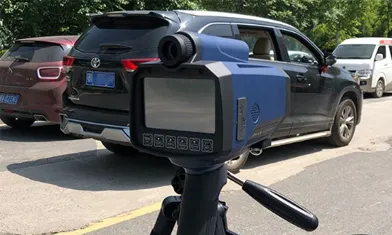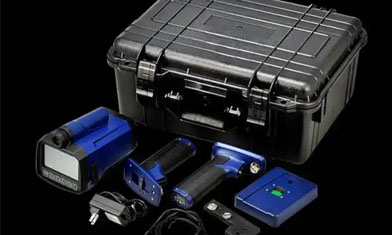How traffic enforcement uses handheld laser speed guns
Handheld laser speedometers, with their high accuracy of ≤±1 km/h, have become a core tool for traffic police to conduct precise enforcement in temporary control areas such as around schools and under construction. Their use must strictly adhere to the "Traffic Police Road Duty and Enforcement Work Specifications," ensuring legality, accuracy, and safety throughout the entire process. The specific process is as follows:
1. Pre-enforcement Preparation: Equipment and Scenario Compliance Verification
Equipment Calibration and Commissioning
Confirm that the device is within its valid metrological calibration period (for example, Yunnan Province requires regular verification by the Metrology Institute). After powering on the device, verify the device serial number, calibration date, and other information displayed on the display to ensure compliance with GA/T832 technical specifications.
Preset parameters based on the speed limit of the enforcement section: Urban roads typically set a speed limit of 30-60 km/h, while highways set it to 80-120 km/h. Also, enable the "Speeding Threshold Warning" function (for example, if the speed limit is 60 km/h, set a 5 km/h buffer to prevent false positives). Test the device's laser transmission and reception capabilities: Aim at a stationary object (such as a road sign) to confirm the displayed speed is zero. Aim at a low-speed vehicle at a short distance and compare the speed to the visually estimated speed to verify the device's accuracy.
Enforcement Site Selection and Control
Select a safe, unobstructed location with a wide field of view. Preferentially set up in the roadside emergency lane or behind a guardrail to avoid disrupting normal traffic flow. If located on the shoulder of the road, a "speed measurement sign" should be placed 200 meters in front of the speed measurement point.
Avoid strong backlight and highly reflective environments (such as glass curtain wall sections) to prevent interference with the laser beam. In rainy or snowy weather, verify the device's waterproof rating (typically IP65 or higher) to avoid measurement errors caused by humidity.
Auxiliary Equipment: Linked HD cameras (resolution ≥1080P) and a police communication system (for data synchronization) ensure simultaneous speed measurement and evidence collection.
II. On-site Operation Procedure: Accurate Speed Measurement and Target Locking
Target Aiming and Speed Measurement
Use the "three-point, one-line" aiming method: Aim the eyepiece at the front of the vehicle, focus the laser spot on the hood or license plate (avoid aiming at reflective areas on the windshield), and maintain a single aiming time of 0.5-1 second.
Effective Speed Measurement Range: On urban roads, the range is typically 30-200 meters, and on highways, it can be extended to 300 meters to avoid errors caused by exceeding the device's range.
Managing Complex Traffic: When encountering multiple vehicles running parallel, aim at each vehicle one by one in a "near to far" order, taking two measurements per vehicle and averaging them to eliminate interference from adjacent vehicles' laser reflections.
Speeding Detection and Data Recording
When the device's displayed speed exceeds the preset threshold, an audible and visual alarm is automatically triggered, and the screen simultaneously freezes to display data such as "vehicle speed, measurement time, and distance." Immediately capture at least two panoramic images at different times using the linked camera. The images must clearly show the vehicle license plate and exterior features, and overlay information such as the speed measurement point location, speed limit, and device security code.
Manually record key data in the "Speed Measurement Enforcement Record Form": including the vehicle license plate, measurement time (accurate to the second), measured speed, speed limit, and the name of the enforcement officer, ensuring consistency with the data stored on the device.
III. Evidence Collection and Law Enforcement Disposition: Comply with Legal Standards
Data Verification and Export
Perform a secondary verification of speeding vehicle data: Compare the camera capture time with the speed measurement time (error ≤ 1 second) to confirm that the vehicle speed has not exhibited abnormal values due to device vibration (e.g., momentary jumps exceeding 10 km/h).
Export data to the Police Communication System via USB or wireless module, generating an encrypted data package containing "speed measurement data + captured image + device information." The data package must include an unalterable electronic security code. Print a simplified penalty notice on-site, noting "Detailed evidence available through the XX platform" to ensure the parties' right to know.
Graded Disposition and Documentation
For vehicles exceeding the speed limit by less than 50%, simplified procedures will apply, and a "Public Security Traffic Management Simplified Procedure Penalty Decision" will be issued on the spot, detailing the violation, the basis for the penalty, and remedies.
For vehicles exceeding the speed limit by more than 50%, immediately notify the traffic police at the next interception point via handheld devices. Compulsory measures will be taken, and an "Administrative Compulsory Measures Certificate" will be generated. The data will also be uploaded to the traffic violation processing system.
If data anomalies are detected (e.g., blurry images, no speed record), the record will be invalidated on the spot and a new measurement will be conducted to ensure that every enforcement record meets the evidentiary standards.
IV. Enforcement Precautions: Risk Avoidance and Standardized Operation
Device Usage Taboos
Do not measure speed while in motion: Handheld laser speed guns rely on a stationary reference to calculate distance differences. Using them while moving can result in doubled errors. Maintain a stable posture and the device at all times. Avoid direct laser light on the human body: The device uses a Class I safety laser, but it should still be kept out of the driver's eyes. The preferred aiming point is metal parts of the vehicle.
Continuous operation should not exceed 2 hours: The device typically has a battery life of 20 hours (using two AA batteries). However, prolonged use can affect accuracy due to heat buildup, so a 10-minute break is required every hour.
Key Compliance Points for Law Enforcement Procedures
No covert enforcement: Speed measurement points must be clearly marked within 500-1000 meters, and the device must be visible. Covering with clothing or vehicles is prohibited.
Data retention for at least 6 months: Exported speed records and images must be stored synchronously on the public security intranet server for administrative review or litigation review (for example, in Pu'er City, original data verification is required).
Standardized notification language: When stopping a vehicle, state, "You exceeded the speed limit on XX road section at XX time. The measured speed was XX km/h. The speed limit was XX km/h." The speed data and captured images must be presented.





















